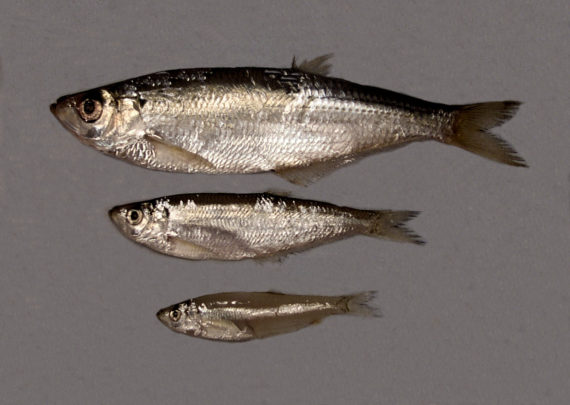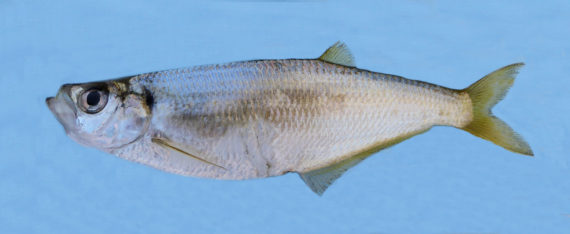Yellowfin Herring, Pliosteostoma lutipinnis
 Yellowfin Herring, Pliosteostoma lutipinnis. Fish provided by the commercial bait salesmen of the greater Los Cabos area, Baja California Sur. Sequence above shows the maturation of the species from juvenile when most of their body is transparent to adult. Lengths: 25 cm (9.8 inches), 14.1 cm (5.6 inches), and 10.0 cm (3.9 inches).
Yellowfin Herring, Pliosteostoma lutipinnis. Fish provided by the commercial bait salesmen of the greater Los Cabos area, Baja California Sur. Sequence above shows the maturation of the species from juvenile when most of their body is transparent to adult. Lengths: 25 cm (9.8 inches), 14.1 cm (5.6 inches), and 10.0 cm (3.9 inches).
 Yellowfin Herring, Pliosteostoma lutipinnis. Fish provided by the commercial bait salesmen of the greater Los Cabos area, Baja California Sur, April 2019. Length: 22 cm (8.7 inches).
Yellowfin Herring, Pliosteostoma lutipinnis. Fish provided by the commercial bait salesmen of the greater Los Cabos area, Baja California Sur, April 2019. Length: 22 cm (8.7 inches).
The Yellowfin Herring, Pliosteostoma lutipinnis, whose common Spanish name is arenquilla aleta amarilla, is a member of the Longfin Herring or Pristigasteridae Family, and is known in Mexico as arenquilla aleta amarilla. Globally, there are thirty-eight species in the Pristigasteridae Family, that have been placed into nine genera. There is only one species in the Pliosteostoma genus, this fish which is found in Mexican waters of the Pacific Ocean.
The Yellowfin Herring has an elongated relatively deep compressed body that are very flexible, thus giving them an awkward gangly appearance especially when swimming. Simply put – this is a weird duck! They are dark dorsally and transition to silvery white ventrally. They have a black spot behind their gill covers. Their fins are yellow. Juveniles have transparent bodies with a silvery mid-flank stripe. They have a large head, a short pointed snout, large eyes, and a projecting lower jaw. Their large oblique mouth extends to mid-eye and is equipped with small teeth located on the roof of the mouth. Their anal fin has 13 rays and a long base and originates before the dorsal fin; their caudal fin is forked; their dorsal fin has 13 rays and originates behind the mid-point of the body; their pectoral fins are exceedingly long; and, they do not have pelvic fins. They have 15 to 17 gill rakers on their first arch. Their body is covered with rough scales. Their lateral line is complete and extends into the caudal fin base with 27 or 28 scutes along their belly.
The Yellowfin Herring is a coastal pelagic species found over sandy bottoms at depths up to 50 m (165 feet). They reach a maximum of 25 cm (10 inches) in length. They travel in large schools and are known to enter brackish estuaries. They consume zooplankton and small invertebrates including crab and shrimp. Their eggs and larvae are pelagic. The Yellowfin Herring is poorly studied with very limited information available about their lifestyle and behavioral patterns including specific details on age, growth, longevity, movement patterns, diet, habitat use, and reproduction.
The Yellowfin Herring is a resident of Mexican waters of the Pacific Ocean but has a limited range being found around the tip of the Baja, Baja California Sur, and along the coast of the mainland from Mazatlán, Sinaloa, south to Guatemala.
The Yellowfin Herring can be easily confused with the Hatchet Herring, Ilisha fuerthii (dorsal fin originates before anal fin origin; small pelvic fins), the Pacific Longfin Herring, Opisthopterus dovii (anal fin originates closer to caudal fin than snout; dorsal fin originates closer to caudal fin than pectoral fins; dark line along back), and the Tropical Longfin Herring, Neoopisthopterus tropicus (very long anal fin base; small pointed dorsal fin; silver stripe along flank).
From a conservation perspective the Yellowfin Herring are currently considered to be of Least Concern with stable, widely distributed populations. They essentially disappeared from the greater Los Cabos area for the last ten years but in early 2019 returned but in not in abundance. They are virtually weightless and of limited value to most. They are retained by subsistence fishermen on a limited basis and used as live bait, for chum, and as cut bait by coastal fishermen.